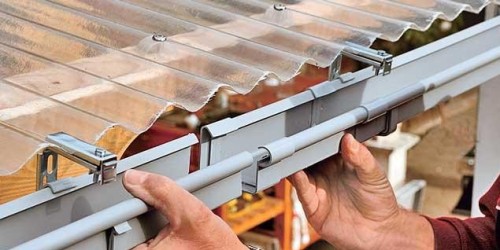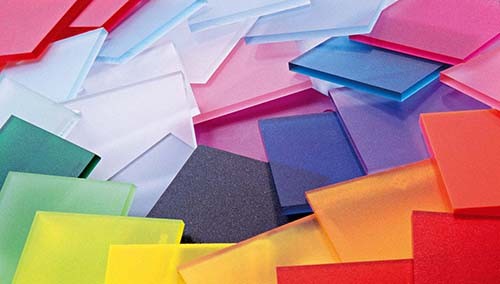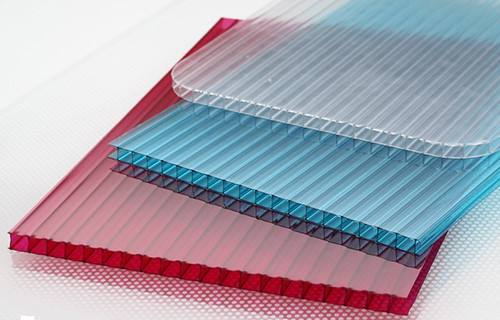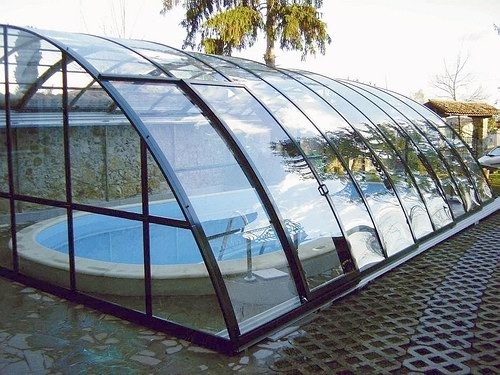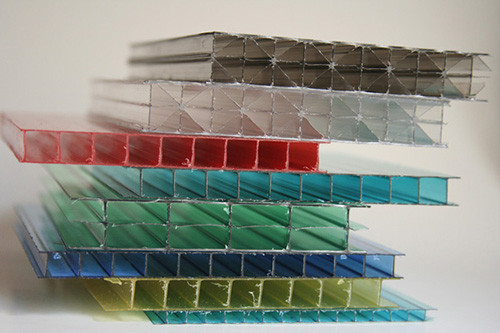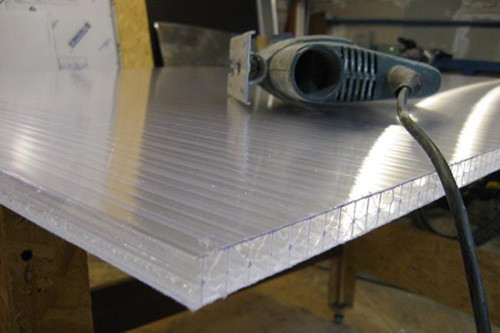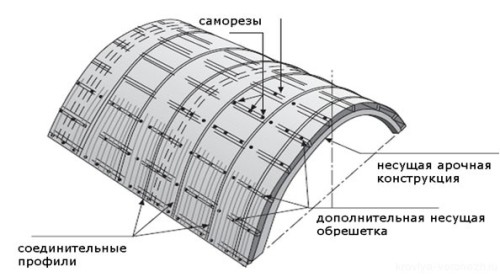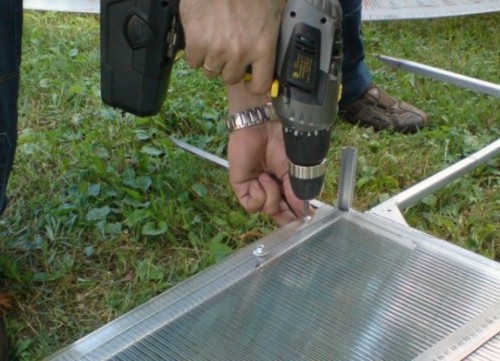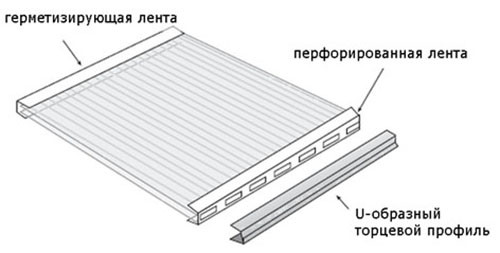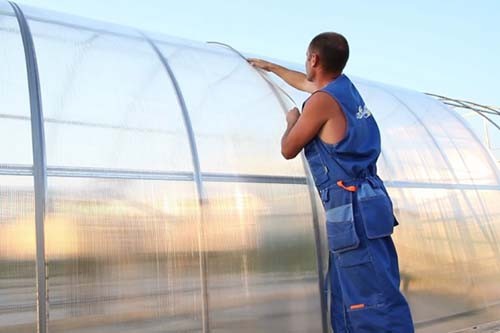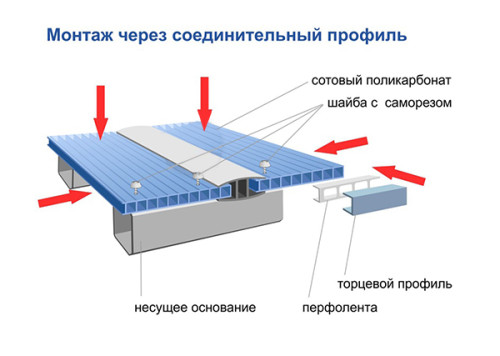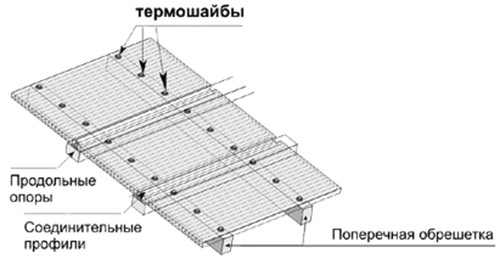Polycarbonate is a product of polymeric origin, which rightfully can be called one of the most successful inventions of humanity recently. This material is characterized by high plasticity, strength, low weight and low density. It is used in almost all spheres of life of people, ranging from the construction of spacecraft, ending with the manufacture of toys and mobile phones. For builders, polycarbonate is also a convenient and practical material with which you can quickly make a visor over the house, a greenhouse for vegetables or another building. In this article we will tell you everything you need to know for the installation of polycarbonate with their own hands.
Content
Product specifications
Polycarbonate replenished the range of building materials relatively recently, but immediately gained popularity, thanks to its exceptional qualities. It has so versatile properties that applies in a variety of areas: the automotive industry, construction, s / c ... Masters-self-taught is also helpfully praised polycarbonate, because it is easy and easy to work with it even without professional skills.
We will not consider the complex chemical composition of polycarbonate in detail, but only clarify that it is a type of plastic. Possessing high heat resistance, it can take all sorts of shapes, and do it repeatedly without loss of quality.
Polycarbonate advantages:
- high strength;
- resistance to mechanical exposure, load load;
- able to withstand critically low temperatures up to -200c and heat to + 100 ° C and higher (especially temperature-resistant species);
- well misses light;
- resistance to chemicals (some acids, oxidizing agents, salts). Concentrated acid can destruct the material. But such a habitual domestic as acetone is also able to dissolve it, so when careing for a polycarbonate surface, in no case attempt to bring the stain or erase the dirt with acetone;
- high fire resistance - it is almost impossible to set fire to it, and if it turns out, the polycarbonate almost immediately immediately;
- complete biological inertness (in the production process is sterilized);
- minimal water absorption - practically does not miss moisture, which is why there are excellent canopies, visors and other protective structures from polycarbonate.
However, polycarbonate has disadvantages. For example, it loses strength with the long-term exposure of direct sunlight, that is, a very hot summer can be lost resistance, if it does not strengthen it additionally and do not cover the protective film. The same applies to the long exposure to hot water. Supporting parts that test the constant voltage can be collapsed with time under the influence of gasoline, technical oils, etc.
Nevertheless, none of these shortcomings prevents actively using polycarbonate in construction, because with careful use and proper care, it is capable of listening almost forever.
Types of polycarbonate
There are two main types of polycarbonate - film (monolithic, leaf) and cellular. Each of them today is indispensable in construction, advertising, everyday life and other spheres of life. Film material, in turn, is divided into several species depending on the scope of use.
Types of polycarbonate:
- Protective-hard laminated coatings with high wear resistance.
- Optical - making TV screens, computers, laptops, tablets, smartphones, etc.
- Non-combustible film for the manufacture of electrical engineering and electronics.
- Designer - advertising production, investigative activities and other creative spheres.
- Laserogetable - lamination of documents.
- Film polycarbonate can be purchased in the form of rolls or sheets of different thickness.
Cellular polycarbonate is most often used in the construction of modern buildings. It is used to create decorative elements, inserts, canopies, etc. Designers and architects appreciate it for high strength at low weight. The cellular is called it because if you look at the material in the context, you can see small cells (compartments), resembling bee honeycombs.
In addition to high strength and convenience in use, cellular polycarbonate has good thermal insulation characteristics, resistant to temperature differences and aesthetic appearance. This allows you to apply it not only in construction, but also internal finishing of houses and outdoor advertising. In the latter case, to prevent the negative effects of ultraviolet, polycarbonate are covered with a protective film.
The cellular durable material practically does not miss the sound, so office partitions and sound barriers on the motorways are built from it. Because of its flexibility, polycarbonate is suitable not only for the construction of roofs and canopies of the original forms, but also to create a bulk advertising - letters, figures, etc.
What you need to know for mounting
Before starting the installation of polycarbonate, you need to know how to install it correctly, what tools and materials to use and in general which side of the sheets turn. Competent and coordinate actions will allow you to get a quality result.
How to cut polycarbonate
Polycarbonate cutting is one of those operations that any master for high-quality installation should be able to perform. Since the material is sold in the form of sheets or in rolls, it has to be customized to the desired frame size.
The cutting process itself is quite simple, but still has its own specifics. To work, you will need a special cutting power tool, for example, circular saw. In order to smoothly cut a sheet of polycarbonate, experts recommend using carbide discs with small and undiluted teeth.
Useful advice: Do not remove the protective film in front of the cut - it needs to be done only after the installation is completed. Otherwise, scratches and scratching may appear on sheets.
Before cutting sheet, it is necessary to secure it to fix it so that the vibration does not affect the quality of the cut. When the work is completed, remove the plastic chips from the inner cavities. Since their main task in the course of operation is the removal of condensate, the "honeycomb" scored will accumulate moisture.
Orientation of panels
Circular polycarbonate plates have rigidity ribs that go along the entire length. Based on this fact, the panel should be set so that the internal empties have access to air. Otherwise, condensate has nowhere to go out.
If you need to create a vertical surface of polycarbonate, the rigid ribs must be positioned vertically. For the scathing glazing, they need to spend along the rods, and when arched arches - on the arc.
Modern polycarbonate is produced with a protective coating applied to the outer surface of the panel. There is also a labeled film that helps to navigate during installation, so it is necessary to take it only at the very end of work.
Cellular polycarbonate created for arched structures should bend through a strictly defined radius. Usually this parameter is specified on the package or in the technical documentation for each type of panels.
How to drill holes
To make a hole in polycarbonate, you will need a conventional perforator and a set of nozzles. You can only drill between rigidity ribs and at least 4 cm from the edge of the panel, otherwise the design will lose strength.
When creating holes in a sheet of polycarbonate, it should be borne in mind that when the material is heated or cooling, they will deform. For this reason, their diameter should be slightly larger than the diameter of the legs of the thermoshair (by 1-2 mm).
When installing the monolithic plates of polycarbonate polycarbonate, the high length of the hole must be an ellipsoid shape with the axis directed towards the largest leaf measurement. The drilling angle can be selected in a specific range: from 90 ° to 110 °. If you go beyond these values, you will not be able to securely fix the washer, and the panel turns. Accordingly, the heat and sound insulation quality of the material will deteriorate.
How to seal ends
Installation of cellular polycarbonate involves thorough sealing of all seams. At the top of the ends, glue with a solid flat-softener, and at the bottom - perforated ribbon, so as not to interfere with condensate.
All ends of cellular panels must be closed. It is not worth sticking them to the stationery scotch because it is not intended for such operating conditions. For unhindered condensate removal, it is necessary to organize several small holes in the end profile. They can be drilled drill in the same way as when attaching sheets.
Tools and materials
There are various ways to connect to the connection, so different tools may need to be installed. And since all panels need to be attached to frames, which are also different, you should carefully examine all the methods of installation and materials that are needed for them.
We list a universal set of tools and materials that will be useful for any fastening method:
- polycarbonate sheets (standard 210x210 cm). Before buying, you need to work out the drawing of the object and calculate the required amount of material on the total area;
- if you do not have a circular saw with the desired nozzle, the polycarbonate can be cut down with a metal with a metal;
- detachable or in-point connecting profiles;
- skate, curly and angular profiles;
- screwdriver (screwdriver);
- self-tapping screw;
- galvanized nails;
- hammer;
- special weatherproof glue for carbonate or silicone glue;
- to create a frame, you can use metal pipes or wooden bars;
- bolts with thermoshairs for fastening sheets to a frame.
Installation of polycarbonate
Polycarbonate sheets can be attached in two ways: on detachable and deline profiles. Consider in more detail each of them.
Deligious profiles:
- The basis of the profile attach nails to a fixed wooden bar or frame, if possible. If it turns out to navigate the profile directly to the frame, use not nails, but the bolts with thermoshabami. Install the fasteners with a step from 30 to 50 cm depending on the length and weight of the future design (the harder and longer, the less step).
- Lay into the profile database sliced \u200b\u200bpolycarbonate panels.
- Put the profile protective cover and attach it to a snap-down lock.
If the instructions described above seemed simple and understandable to you, then with all-point profiles you will cope in two bills.
Installation instructions polycarbonate one-piece profile:
- To attach the finished frame profile bar by means of screws with thermowasher.
- Cut sheets of polycarbonate desired dimensions.
- Insert sheets into the profile. For greater reliability and better waterproofing, before this, you can wipe the profile base with silicone sealant.
- Close the side edges of panels with protective corner profiles to prevent moisture from entering internal holes.
IMPORTANT: In both cases, during installation, leave a thermoderification gap from 2 to 5 mm between the inside of the profile and the end of the panel. In order for the moisture unhindered from the cavities, make the holes at 1.5-2 mm at the bottom of the panel at a distance of 25-30 cm from each other.
Mount the polycarbonate to the frame can even be a beginner self-taught builder. The main thing is to be able to handle elementary tools and purchase all the necessary fasteners. But still this work has its own nuances, and one of them is the strength of twisting fasteners. It is very important not to twist the washers so that the polycarbonate panel does not cracked or not rushed. If this happens, waterproofing will break, and the quality of the design will fall sharply. To ensure that it does not happen, be sure to use thermoshaba - they evenly distribute the load and help not sink the surface with the self-tapping screw.
Useful advice: To choose the right fastener, remember one rule - the height of the height of the thermoshaba should be the same as the width of the polycarbonate panel.
Finally - a useful video on the installation of polycarbonate:

